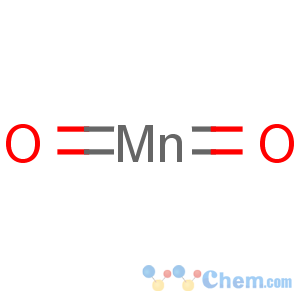Title: Manganese Dioxide
CAS Registry Number: 1313-13-9
Synonyms: Manganese binoxide; manganese peroxide; manganese superoxide; black manganese oxide
Molecular Formula: MnO2
Molecular Weight: 86.94
Percent Composition: Mn 63.19%, O 36.81%
Literature References: Occurs in nature as the mineral
pyrolusite, or made artificially (pptd). The native product is heavy, steel-gray when in lumps, black when powdered; the pptd product is a brownish-black, fine powder. Both usually contain some Mn3O4 and some water. When ignited evolves oxygen, leaving Mn3O4. Lab prepn: Moore
et al., J. Am. Chem. Soc. 72, 856 (1950); Covington
et al., Trans. Faraday Soc. 58, 1975 (1962). Toxicity study: D. J. Holbrook, Jr.
et al., Environ. Health Perspect. 10, 95 (1975). Review of use as reagent: J. S. Pizey,
Synthetic Reagents vol. 2 (John Wiley, New York, 1974) pp 143-174.
Properties: Tetragonal crystals (rutile structure). Insol in water, nitric or cold sulfuric acid. Slowly dissolves in cold HCl with evolution of Cl2; in presence of hydrogen peroxide or oxalic acid it dissolves in dil H2SO4 or HNO3.
Strong oxidizer; should not be heated or rubbed with organic matter or other oxidizable substances, e.g., sulfur, sulfides, phosphides, hypophosphites, etc. LD50 orally in rats: >40 mmole/kg (Holbrook).
Toxicity data: LD50 orally in rats: >40 mmole/kg (Holbrook)
Use: The mineral is the source of manganese and all its compds; largely used in manuf manganese steel; oxidizer; in alkaline batteries (dry cells); for making amethyst glass, decolorizing glass; painting on porcelain, faience and majolica. The ppt is used in electrotechnics, pigments, browning gun barrels, drier for paints and varnishes, printing and dyeing textiles.

